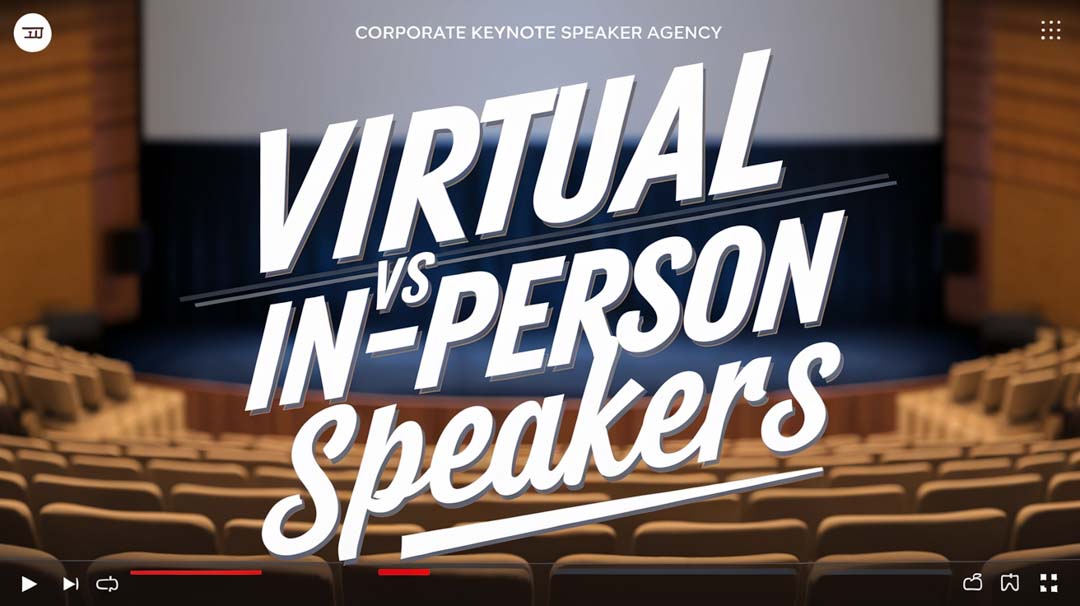You’re facing a vital decision that will impact your next event’s success: should you book a virtual or in-person keynote speaker? It’s 2025, and while the world has largely moved past pandemic restrictions, both formats offer distinct advantages that weren’t as clear-cut just a few years ago. Your choice will affect everything from your budget to audience engagement levels, and what worked for your organization in the past might not be the best solution today. Let’s explore what’s really at stake.
Key Factors Driving the Virtual Vs In-Person Speaker Decision
The choice between these two formats largely depends on your event’s objectives, audience nature, technological requirements, and accessibility needs.
When deciding between virtual and in-person speakers, consider these key factors:
- Event Objectives and Audience Nature: Large-scale events benefit from in-person keynote speakers for memorable experiences, while webinars and virtual workshops are better suited for virtual speakers due to their reach and interactive capabilities.
- Technological Advancements: Leverage tools like live streaming and interactive apps to enhance engagement.
- Accessibility and Inclusivity: Virtual events offer wider reach and inclusivity with features like closed captions and translation services.
- Personalization: Use data and analytics to deliver tailored content. This approach ensures content resonates and educates specifically to your audience’s needs and interests.
- Global Participation: Virtual events allow for global participation, overcoming logistical barriers. Corporate event planners can access international speakers from both Las Vegas and Kent offices for diverse talent options.
Cost-Benefit Analysis of Virtual and In-Person Keynote Experiences
When planning a pivotal event, the decision between virtual and in-person keynote speakers hinges not only on the event’s objectives and audience needs but also on the financial implications. In-person speakers can range from $5,000 to over $100,000, depending on their expertise and reputation, while virtual speakers typically charge between $500 to $10,000.
Fees for in-person speakers often include additional costs for travel, accommodation, and venue. Fortune 500 companies frequently utilize both virtual and in-person keynote speakers for their corporate functions, workshops, and team-building events.
Virtual speakers charge 50% to 70% of an in-person fee, offering potential cost savings.
Factors such as event format, duration, and complexity can affect fees. Audience size and type can also influence speaker fees, with larger audiences or high-level executives warranting higher rates. Rights to record and distribute the webinar or specific technical setups can increase fees.
Pre-recorded content is generally more cost-effective than live interaction sessions.
Best Practices for Maximizing Impact in Both Virtual and Live Formats
- Conduct thorough audio-visual rehearsals to polish presentation delivery and minimize technical issues.
- Use storytelling techniques to captivate the audience and foster participation through interactive elements like polls and Q&A sessions.
- Select a platform that supports high-definition streaming and interactive features for virtual events.
- Utilize nonverbal cues like body language and facial expressions in live presentations.
- Research the audience to tailor messages that connect with their needs and expectations in both formats.
- Effective gamification elements, such as incorporating live polls, can significantly boost attendee engagement and satisfaction in virtual events.
- Partnering with industry experts can enhance event credibility and provide attendees with valuable, specialized insights.
Annual Leadership Summit
Organizations hosting annual leadership summits face unique considerations when deciding between virtual and in-person keynote speakers. Your summit’s success hinges on creating meaningful connections and fostering collaborative leadership development across your organization.
In-person speakers excel at reading the room’s energy, facilitating interactive exercises, and building personal rapport with your leadership team. They’re particularly effective for team-building activities and networking sessions that define most leadership summits.
Virtual speakers, however, can offer distinct advantages for multi-location organizations. You’ll save on travel costs and gain access to high-profile speakers who might otherwise be unavailable. Virtual sessions also allow you to record content for future leadership training and enable real-time participation from global team members through interactive polling and breakout rooms.
Experienced speakers like Will Baggett have demonstrated that interactive keynote sessions can maintain engagement levels of over 98% approval ratings regardless of the delivery format.
Csa’s Emergency Speaker Replacement
Has your keynote speaker ever canceled at the last minute? CSA’s emergency speaker replacement service guarantees your event won’t miss a beat. You’ll have immediate access to their roster of 1000+ professional speakers who can step in at a moment’s notice, whether you need a virtual or in-person presenter.
CSA’s team leverages their extensive network across the US, UK, Europe, and Middle East to quickly match your event with a qualified replacement speaker. They’ll consider your event type, audience expectations, and subject matter to find the perfect substitute.
You’ll benefit from their cross-cultural expertise and international event capability, enabling smooth changeovers even for global conferences. When emergencies strike, CSA’s professional event management team works around the clock to maintain your event’s success. Their diverse roster includes inspirational leadership speakers who can deliver compelling presentations designed to increase engagement and productivity.
Final thoughts
You’ll need to carefully evaluate your organization’s specific needs, budget constraints, and audience expectations when choosing between virtual and in-person keynote speakers. Consider implementing a hybrid approach that combines both formats to maximize reach and engagement. Whatever format you select, guarantee your decision aligns with your event objectives and leverages available technology to deliver meaningful, impactful experiences for all participants. Additionally, it’s essential to prepare your speakers for the format they will be presenting in, as the dynamics of virtual and in-person interactions differ significantly. Providing them with best practices for Q&A sessions can enhance audience engagement and ensure that participants feel heard and valued. By integrating feedback mechanisms and employing interactive tools, you’re more likely to create a memorable event that resonates with your audience.
Corporate Speaker Agency (CSA) is a premier international speaker bureau with offices in the UK and Las Vegas, connecting organizations with world-class keynote speakers and talent since 2015. Our team of seasoned event professionals brings over two decades of industry experience to curate exceptional speaking engagements for Fortune 500 companies, government agencies, and educational institutions worldwide.
As pioneers in conference speaker sourcing across the USA and UK, we represent an elite roster of industry experts spanning business, technology, innovation, leadership, and entertainment. Through CSA and our sister company Corporate Entertainment Agency, we provide comprehensive talent solutions including keynote speakers, motivational experts, entertainers, and event facilitators.
Our commitment to excellence and deep understanding of client needs has established us as a trusted partner in creating impactful corporate events, from high-stakes conferences to intimate team-building workshops. With access to thousands of distinguished speakers and entertainers, we pride ourselves on delivering precisely matched talent for any occasion and budget.



















